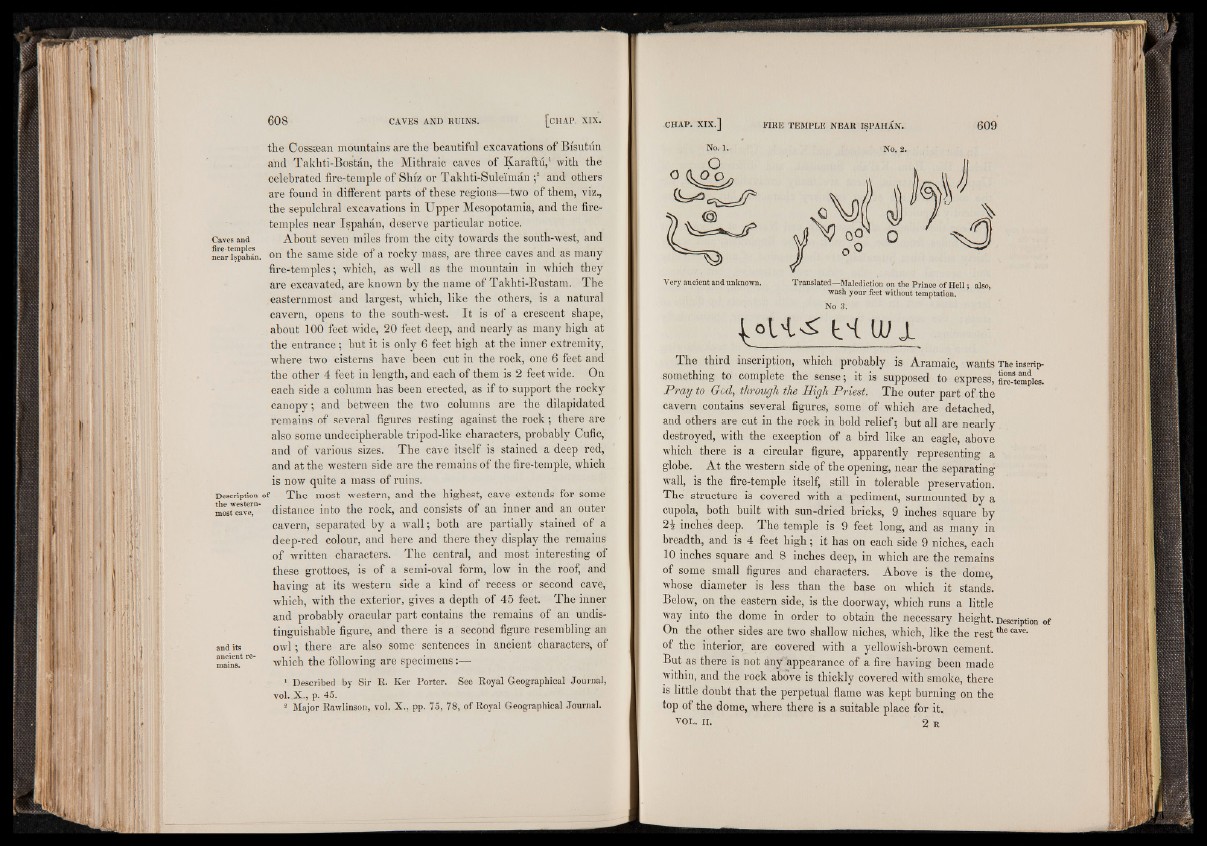
the Cosssean mountains are the beautiful excavations of Bisutun
and Takhti-Bostan, the Mithraic caves of Karaftu,1 with the
celebrated fire-temple of Shfz or Takhti-Suleiman f and others
are found in different parts of these regions—two of them, viz.,
the sepulchral excavations in Upper Mesopotamia, and the fire-
temples near Ispahan, deserve particular notice.
Caves and About seven miles from the city towards the south-west, and
near Ispahan, on the same side of a rocky mass, are three caves and as many
fire-temples; which, as well as the mountain in which they
are excavated, are known by the name of Takhti-Bustam. The
easternmost and largest, which, like the others, is a natural
cavern, opens to the south-west. It is of a crescent shape,
about 100 feet wide, 20 feet deep, and nearly as many high at
the entrance; but it is only 6 feet high at the inner extremity,
where two cisterns have been cut in the rock, one 6 feet and
the other 4 feet in length, and each of them is 2 feet wide. On
each side a column has been erected, as if to support the rocky
canopy; and between the two columns are the dilapidated
remains of several figures resting against the rock; there are
also some undecipherable tripod-like characters, probably Cufic,
and of various sizes. The cave itself is stained a deep red,
and at the western side are the remains of the fire-temple, which
is now quite a mass of ruins.
Description of The most western, and the highest, cave extends for some
mosrS™™" distance into the rock, and consists of an inner and an outer
cavern, separated by a wall; both are partially stained of a
deep-red colour, and here and there they display the remains
of written characters. The central, and most interesting of
these grottoes, is of a semi-oval form, low in the roof, and
having at its western side a kind of recess or second cave,
which, with the exterior, gives a depth of 45 feet. The inner
and probably oracular part contains the remains of an undis-
tinguishable figure, and there is a second figure resembling an
and its owl; there are also some' sentences in ancient characters, of
mains'!4 which the following are specimens:—
1 Described by Sir R. Ker Porter. See Royal Geographical Journal,
vol. X., p. 45.
s Major Rawlinson, vol. X., pp. 75, 78, of Royal Geographical Journal.
No. 2 .
Very ancient and unknown. Translated—Malediction on the Prince of H e ll; also
wash your feet without temptation. ’ ’
No 3.
hd. Ul JL
The third inscription, which probably is Aramaic, wants The inscrip-
something to complete the sense; it is supposed to express, fireltempies.
P ra y to Gcd, through the High Priest, The outer part of the
cavern contains several figures, some of which are detached,
and others are cut in the rock in bold relief; but all are nearly
destroyed, with the exception of a bird like an eagle, above
which there is a circular figure, apparently representing a
globe. At the western side of the opening, near the separating
wall, is the fire-temple itself, still in tolerable preservation.
The structure is covered with a pediment, surmounted by a
cupola, both built with sun-dried bricks, 9 inches square by
2 i inches deep. The temple is 9 feet long, and as many in
breadth, and is 4 feet high; it has on each side 9 niches, each
10 inches square and 8 inches deep, in which are the remains
of some small figures and characters. Above is the dome,
whose diameter is less than the base on which it stands.
Below, on the eastern side, is the doorway, which runs a little
way into the dome in order to obtain the necessary height. Description of
On the other sides are two shallow niches, which, like the restthe caTe-
of the interior, are covered with a yellowish-brown cement.
But as there is not any'appearance of a fire having been made
within, and the rock above is thickly covered with smoke, there
is little doubt that the perpetual flame was kept burning on the
top of the dome, where there is a suitable place for it.
v o l . II. 2 R